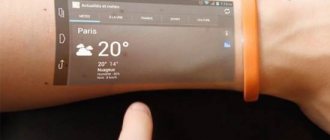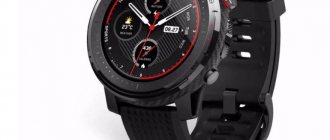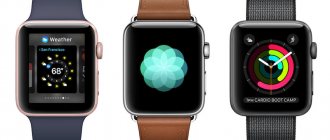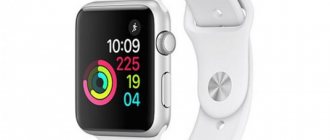Smart devices are all the rage, from smart TVs that show movies and TV shows on your schedule and let you create your own playlists, to wearable electronics like smart watches and fitness bands. The latter are visually similar, can partly replace the now seemingly bulky smartphones, and have overlapping functionality; but there is also a difference. From the article from the Good Deeds Service, you will learn how smart watches differ from fitness bracelets - and you will understand how to decide if you plan to buy one. For each category, we have listed the TOP models for 2021 - choose and enjoy new technologies!
Types of smart watches
These gadgets have a number of functions: they record the meters and kilometers you have traveled, and monitor your weight and heart rate . It's part switch and part smartphone. There are modifications of smart watches that can easily replace a mobile device.
There are the following types of Smart Watch:
- Smart Watch with phone functionality. The watch is equipped with a special slot for a SIM card, so it can be used separately from a smartphone.
- Universal. They have a standard set of options.
- Sports devices. The functionality includes all indicators for monitoring the execution of exercises.
- Smart watches for children. They are necessary to attract the child’s attention to exercises and exercises, and to track his location.
- Hybrid. Such mechanisms combine options from existing watches.
In addition to this classification, there is another one:
- Devices that work in conjunction with a smartphone. They are lightweight, ergonomic and last longer without charging, have a powerful processor and perform many operations, which in turn plays a big role in reducing energy consumption. The operation and set of options in the watch depend on the configured applications.
- Full-fledged gadgets that work independently without a phone, especially since the functions of such devices are broader: in combination with a standard purpose, they offer valuable options, which is why they are often used by athletes to calculate special characteristics.
Thus, the first gadget requires connection to smartphones, the second can work independently.
Types of fitness bracelets
There are 2 classes: tracker and smart bracelet.
Class 1 comes in several types; their purpose is to measure body parameters: measuring heart rate, monitoring sleep, monitoring physical activity. They can be a clip, a clamp, or even a mat.
2nd class is a more improved and modernized variety. In addition to activity meters, they notify the owner about calls and SMS and remind him of the activity mode. Such devices are equipped with alarms, timers, etc. Most of them have a small single-color screen, but there are also modifications with a color screen.
What do smart watches and fitness bracelets have in common?
Alarm
Most modern gadgets are equipped with an accelerometer. It is a sensor that counts the number of steps and provides information about the position and space in which the object is located and the speed of its movement.
It also determines how quality the sleep was, records the time of falling asleep and waking up, and divides sleep into phases. There are models with a “smart” alarm clock that can wake up the user with light vibration.
In terms of its ease of use and compactness, a fitness tracker has many advantages over smartwatches.
Time display
Both gadgets have a screen. The smart watch is equipped with a large full-color screen and the option to change the dial. It is more convenient to read information from them than from a second device with a narrow screen that shows the time only in numbers.
Call broadcast
Both gadgets notify about calls. Basically they have a connection to the phone via bluetooth. If fitness trackers notify the owner through vibration and messages, then Smart Watches show on their screens who is making the call and make it possible to answer an incoming call. The watch is equipped with a liquid crystal display, which makes the device heavier.
Message management
Both gadgets transmit signals about messages. The bracelet sends signals through vibration and messages on the screen. By looking at the watch screen and reading the announcement, the user quickly finds out the necessary information. Having received a notification about SMS messages, he can read them on his phone at any time.
Measuring heart rate, steps and calories
Heart rate, steps and calories are measured using an optical device. Sensors built into fitness trackers are more often used by athletes to monitor changes in the body. Smart watches are also equipped with such sensors, but rarely. They are heavier, their size and weight are inconvenient for sports.
GPS tracker
GPS mechanism is rarely found in fitness bracelets. It is better to use a smart watch to track the user's location. The GPS tracker determines the position using signals from special satellites.
Its use is especially convenient for parents who want to be aware of where their child is.
Are fitness bracelets harmful to health - truth or myth?
Fitness bracelets (like many smart watches) motivate us to move more, play sports, and take care of our health, which is important for all of us. As our research shows, among the variety of wearable devices you can find models with accurate sensor indicators, but you can also come across bracelets whose sensors give a very large error when calculating, so you cannot completely rely on them. For example, when counting steps, you set a goal every day, but the pedometer counts extra steps during daily activities. This creates the illusion that you have already achieved your goal. This is the harm from a fitness bracelet.
The same goes for heart rate monitoring metrics. Misleading readings can cause you to overexert yourself or give a false picture of your cardiovascular health during exercise. That is why Roskachestvo’s testing program pays special attention to testing sensors for accuracy. Choose the exact devices using our ratings and read the product descriptions in the cards.
What is the difference between smart watches and fitness bracelets?
The difference between these two gadgets lies both in the range of functions and in other indicators.
Functionality
Smart Watch can:
- make calls, exchange messages;
- play melodies;
- take photos or videos;
- collect information about calls received on the phone, and, if the owner wishes, reject them (all this is displayed on the big screen);
- displaying information about location, speed and distance (thanks to built-in GPS trackers).
Smart Watches are multifunctional, have a touch screen and their own software.
Fitness devices are intended mainly for active people (athletes), for whom it is important to monitor changes in body characteristics during physical activity.
They are able:
- monitor your heart rate;
- measure the number of steps taken;
- count calories;
- wake up the owner;
- provide information about calls from a smartphone.
Most bracelet models are not equipped with GPS sensors; they must be connected to a smartphone.
Weight
Users appreciate the fitness bracelet because it is light and almost imperceptible in their hands. Large watches are inconvenient when playing sports or while sleeping.
Autonomy
The watch works independently for 1-3 days, and with the energy saving mode turned on - for a week. The autonomy of the bracelets is much higher - from 4 days to a week. Some modifications can last up to one and a half months.
Software
The OS built into the watch makes the device “smart”. It allows you to download and install the necessary applications, take videos and photographs, listen to music, and communicate on social networks. Unlike Smart Watches, fitness bracelets do not have software. The operation of the device is ensured by a specially built-in microcode.
Price
The cost of bracelets ranges from 10 to 80 dollars. And “smart” watches cost much more – from hundreds to several thousand dollars.
What is the difference
Now to the question of how smart watches and fitness bracelets differ from each other. At the same time, both watches and bracelets have a huge number of fans.
There are several main differences that do not allow us to identify the devices in question. Because of this difference, they are perceived as different devices, and therefore the marketing policy is different:
- Operating system. The first difference between a smartwatch and a competitor in the form of a fitness bracelet is the operating system. While smart watches have full-fledged software based on an operating system, bracelets use microcode. But this does not prevent bracelets from offering a number of functions and capabilities similar to OS watches.
- Autonomy. Another difference when comparing smart watches and fitness bracelets is their autonomy. The difference here is quite significant. The watch has a processor, a large display, like for a wearable gadget, an operating system, software, etc. Therefore, all this actively affects energy consumption. Hence less autonomy without recharging. Some watches can last for about a week, but this is rare. With active use, they have to be charged every 1-3 days. The bracelets are much more autonomous due to less load on the battery. Therefore, they can withstand at least a week without any problems. And some models even demonstrate operation without recharging for 1–2 months.
- Weight. When comparing smartwatches and fitness bracelets, another difference catches your eye. It lies in the mass of gadgets. The bracelets are as compact and lightweight as possible. The watch may be heavier.
- Price. If the main guideline when choosing is price, then the bracelet will be the clear favorite. The price of some devices literally starts from 5–10 dollars. Advanced modern models can cost $100–200. If we talk about smart watches, then you rarely see a model costing less than $150–200. Some devices are comparable in price to high-end smartphones.
- Functionality. Despite all the advancement of bracelets, the lack of an operating system, a large display, and minimal dimensions do not allow them to compete with smart watches in such a component as functionality.
It is better to consider all the differences that a smart watch and a fitness bracelet have using specific examples. That is, it is recommended to compare two devices that are potentially suitable for you and review their set of functions, capabilities, additional options, etc.
There are many similarities between the two devices in question. But at the same time, they are separated by a number of distinctive features.
Comparison table of smartwatch and tracker functions
| Functional | Smart watch | Fitness bracelets |
| Alerts | The owner finds out who the call is from, and has the option of rejecting or accepting the call. What is written in the SMS is completely visible to the user. | When there is an incoming call, a vibration signal is received or a notification is received. Most models do not have a call rejection feature. |
| Heart rate monitoring | Depending on the model (for example, for athletes). | The built-in sensor measures heart rate at specified times and intervals. Models with a screen give owners the opportunity to view their heartbeat directly on the screen. |
| Exercise stress | Activity monitoring is accurate, statistics can be seen on the screen, which will allow users to make changes to the training program. | The built-in pedometer and calorie meter show the number of steps and calories burned, but you cannot immediately see the detailed diagram without a smartphone. |
| Alarm | This option is available in any model, but due to the inconvenience of wearing it while sleeping, it does not make sense. | This function is built into earlier modifications. For the option to work in new models, you need to download a special application. Because of their lightness, they cope with this task perfectly. |
| Other widgets | Since the watch has a convenient screen, you can get information about the weather, exchange rates, and in some models (with NFC technology) make a payment at any time. | Widgets only for models with display. Information about the weather or exchange rates can be seen when flipping through desktops. |
The main differences between a smart bracelet and a watch
Every year the differences between fitness bracelets and smart watches are becoming less and less, but they still exist. ☺
Software
The presence of software, in fact, makes wrist gadgets “smart”. In the fitness bracelet, microcode is responsible for the operation, which collects information from the built-in sensors and transmits the data to the smartphone. Smart watches have a full-fledged operating system with an interface adapted for a touch screen.
Autonomy
The sports bracelet can work without recharging for 1 to 1.5 months. Agree, this is very cool autonomy. The smartwatch lasts only 1-2 days in active mode, just like the average smartphone.
Weight
The fitness bracelet is lightweight and compact. It does not burden the hand and does not interfere at all during sleep and sports. Smart watches are heavier and larger. Most users remove them at home and at night.
Functionality
The main task of a fitness bracelet is to control physical activity and encourage a healthier lifestyle. Therefore, almost all functions are “tailored” for sports.
Smart watches are more versatile and functional. It has all the functions of a fitness tracker and actually acts as an intermediary between you and your smartphone. In addition to the above options:
- supports third party applications;
- allows you to control the music and video player on your smartphone;
- synchronizes with other “smart” gadgets;
- makes payments (for example, Apple Watch, Samsung Gear 2).
Price
Fitness bracelets are much cheaper than smart watches. Simple trackers will cost you 80-400 UAH, bracelets with a display - up to 1000 UAH, but functional models from Samsung, Garmin, Microsoft, Fitbit will cost 4000-6000 UAH.
The price of a smart watch starts from 300 UAH and can reach 480,000 UAH (Apple Watch Edition 18-Karat Yellow Gold). And here the role is played not so much by the number of functions as by the brand, design and inlay with precious metals.
So what's better to choose: a smart watch or a fitness bracelet?
If the user is faced with the question of which to choose, he needs to understand that both devices are equipped with many functions.
The functionality of bracelets is more focused on monitoring body indicators, and the potential of smart watches is much higher thanks to the built-in OS.
Users who are interested in health indicators before and after activity will need a fitness tracker. If you need to replace your smartphone with a more convenient gadget, then a smart watch is just right for this purpose.










